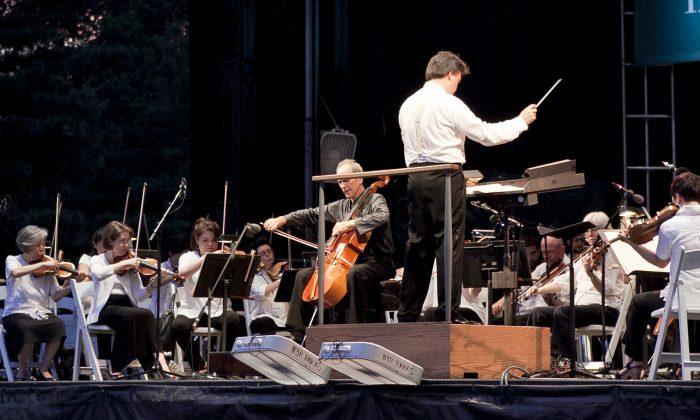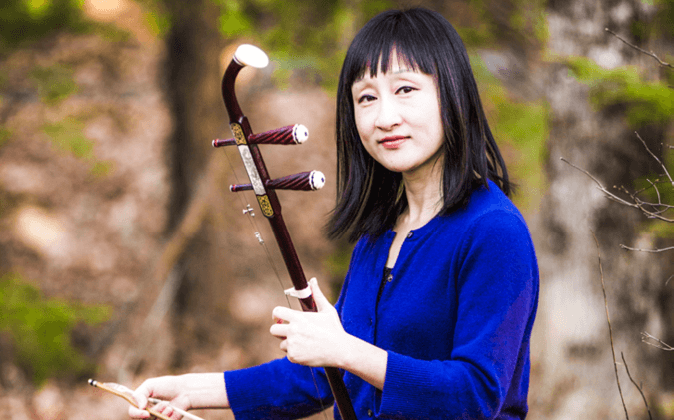NEW YORK—New York Philharmonic Music Director Alan Gilbert returned after intermission to conduct with his shirt untucked.
A small fan blew from behind, causing the loose edge of his shirt to expand like a balloon. It was 92 degrees in Central Park on Monday evening, yet Gilbert conducted at full throttle. He held nothing back, not even his little jumps during exciting phrases.
No humidity, heat, or mosquito could repress the orchestra’s ardor for Tchaikovsky and Dvorak. The musicians were playing at the New York Philharmonic’s series of free concerts held July 10–16.
The New York Philharmonic is known as one of America’s top five orchestras. Leading classical music magazine Gramophone ranked it as the 12th best orchestra in the world in 2012.
Yet the summer outdoor performances provide a rare chance to hear what the orchestra sounds like without the high-tech acoustics of Avery Fisher Hall. Here the musicians are placed in an environment where instruments are pushed to their limits by the blight of heat.
It was uncomfortable for the musicians, and not only physically. When these world-class performers hear their notes collide slightly at times, as humidity causes pegs to slip, it causes mental discomfort as well.
So why do a free concert? So that the intricate beauty of live classical music can be shared with many who would not be able to afford it otherwise. More than 14 million people have attended the free summer park concerts since their inception in 1965.
The outdoor concerts this year were presented by New York Philharmonic board members Oscar and Didi Schafer, who have donated millions to sponsor the free concerts for the past several years.
To the audience’s surprise, the opening performance was not Dvorak’s Cello Concerto, as listed in the program book.
After Oscar Schafer finished his opening speech, he announced that he was going to begin the performance by conducting the overture of Bizet’s “Carmen.” It happened to be his wedding anniversary; he and Didi had met on a blind date at a performance of “Carmen.”
Schafer had a steady hand and rhythm. Perhaps it was too steady. Instead of speeding up at the last bits, it seemed that he purposely slowed down to make sure he had ample control over the steadiness of his rhythm.
All the while, the orchestra caught on gracefully to the unusual change in speed and obeyed the conductor, who wore an ivory suit jacket for the special occasion, despite the weather.
Afterward, Gilbert came on stage, without his suit jacket (although his shirt was tucked in during the first half.)
The orchestra gave a stirring performance of Dvorak’s Cello Concerto in B minor, op. 104. The cello soloist was Carter Brey, who was appointed principal cello to the New York Philharmonic in 1996.
As always, Brey played with an impeccable bright tone. He played the intense string crossings of one of the most difficult cello pieces in the repertoire like a breeze—or perhaps too much like a breeze. His playing seemed to lack its usual depth on Monday night.
But bear in mind that he was wearing a long-sleeve shirt, and he never stopped to wipe the sweat from his forehead—not even during rests. He focused entirely on the perfection of intonation under the extreme temperature, and on being one with the orchestra. His fingers darted ferociously, yet elegantly, across his fingerboard.
His performance showed not only a supreme mastery of highly difficult technical skills, but also sharp concentration and endurance as he played in unity with the orchestra despite conditions.
The woodwinds and brass were surprisingly in tune throughout the majority of the performance, which showed the sensitivity of the musicians’ ears and the ability to react quickly to their neighbors’ changing intonation. They could tell immediately how much lower or higher they should play in order to be in harmony.
The violins played beautifully and powerfully, especially during Tchaikovsky’s Symphony No. 5 in E minor, op. 64.
Their clear 16th notes charged forth in such unity that it sounded as if one person were playing.
Although the New York Philharmonic did not have its sound system or perfect room temperature, the performance of Tchaikovsky’s Symphony No. 5 outdoors showed that the orchestra didn’t really need either.
The overall feeling of symphonic grandeur and power awed listeners at the free outdoor concert, just as it does at all Avery Fisher Hall performances.
The orchestra’s awe-inspiring sound was produced with talent and passion, rather than acoustics.





